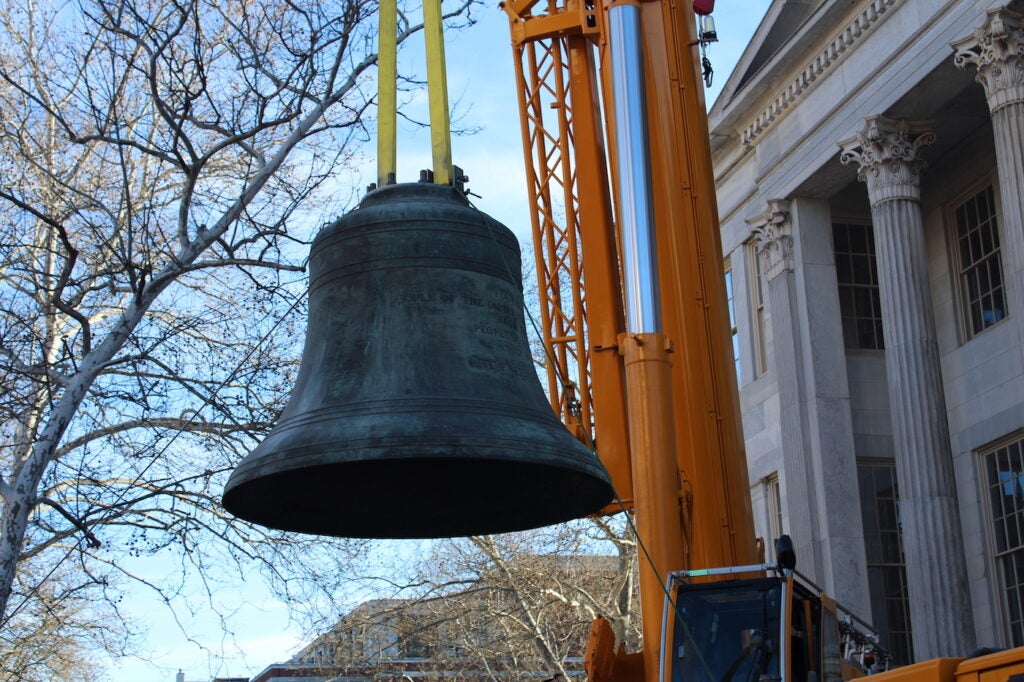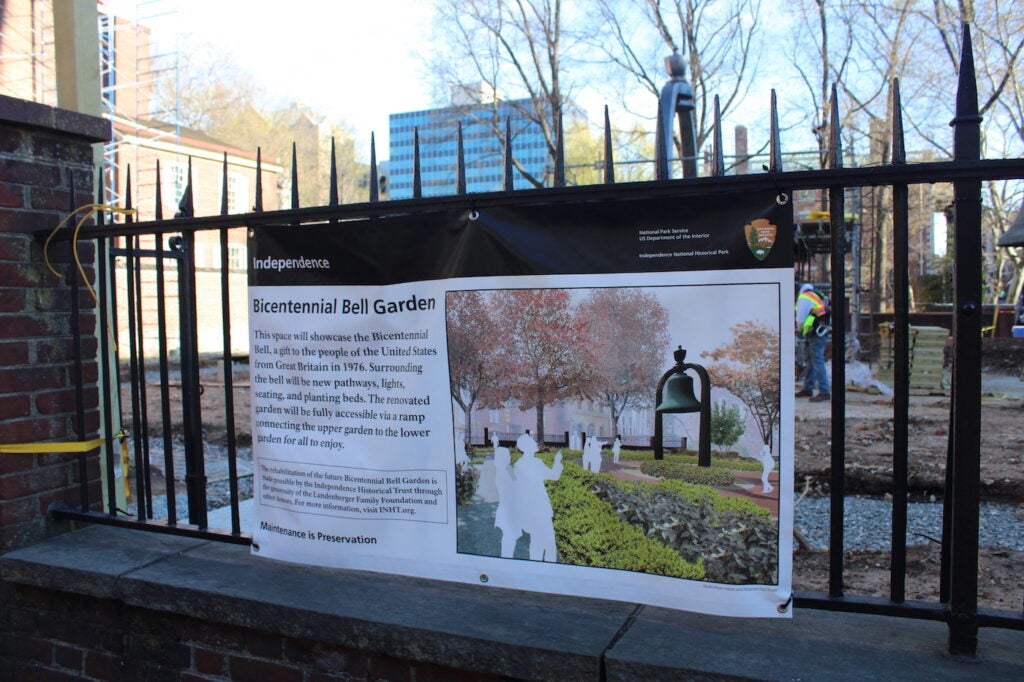The Bicentennial Bell returns to public view in Philadelphia
Project leaders said the Bicentennial Bell Garden would be completed and open to the public by mid to late June.
Listen 1:16
An engineering team placed the Bicentennial Bell, which had been in storage since 2013, in its new home in the Bicentennial Bell Garden on 3rd and Walnut streets on April 6, 2024. (Emily Neil/WHYY)
From Philly and the Pa. suburbs to South Jersey and Delaware, what would you like WHYY News to cover? Let us know!
The Bicentennial Bell, a gift from Queen Elizabeth II to the United States first unveiled in 1976, is once again on display for Philadelphians.
On Saturday, the bell was transported from storage, where it had been since 2013, to its new home at 3rd and Walnut streets. Using a large crane, workers removed the five-foot-tall, 12,000-pound bell from a box and swung it onto a platform in what will soon be the Bicentennial Bell Garden, formerly the Benjamin Rush Garden.

Karie Diethorn, chief curator at Independence National Historical Park, said it’s “really wonderful timing” to return the historic monument to public view ahead of the Semiquincenntial in 2026.
“The Bicentennial was the official opening of Independence National Historical Park, and it was such a powerful year, 200 years of American history to be looking back and to be looking forward about where the United States was going,” Diethorn said.

Jonathan Burton, director of development for the Independence National Historical Trust, a fundraising organization, said the new garden and bell installation is “a very Philadelphia project.” Holzman Iron Studio Ltd., which designed and built the 7,500-pound armature that will hold the bell, is based in Philadelphia, as is the landscape architecture firm that designed the garden, Studio Bryan Hanes. The garden will feature plants that the U.K. and the U.S. traded in the 18th and 19th centuries.
The bell was originally installed at the Independence National Historical Park Visitors Center at 3rd and Chestnut streets, along with bronze plaques featuring text from Queen Elizabeth II’s speech when she presented the gift. Diethorn said those plaques will be included in the new installation, along with interpretative text inviting people to think about the significance of the bell’s — and the country’s — history.

“The fact that the people of Great Britain wanted to help us commemorate that anniversary is kind of like them saying, ‘Hey, we forgive you for the American Revolution,’” she said with a laugh.
“But seriously, the idea that the concept of the American Revolution, the ideas and the ideals that formed, the reason why the American Revolution took place and why the United States was created are still so powerful a part of our identity in America today,” Diethorn said.” “And I think that the Bicentennial Bell reminds us of where we’ve been and where we’re going.”
Diethorn said all Americans have a different relationship to the United States’ past, and that’s why placing the bell in the garden, a space for contemplation, is an integral part of the project.

“There isn’t just one past, there are many pasts,” she said. “But commemorative events like 1976 and 2026 are really the soul of what we think about when we think about why are we a nation. The Bicentennial Bell is this object that will now be available again, for people to see and to contemplate and to think about.”

For Society Hill resident Mike Gary, having a site of contemplation and reflection is what he is looking forward to most about the new garden.
Before construction began, Gary liked to sit on a certain bench in the Benjamin Rush Garden to slow down and soak up some sun.

He’s been following the progress on the Bicentennial Bell Garden, and came out on Saturday morning to see the bell be lifted into place.
“To see it literally transformed to this new being from top to bottom…For me, it’s history. It’s pretty cool,” Gary said.

Diethorn said having an additional green space for neighborhood residents like Gary was another goal of the project.
“It’s also important in a really bustling, busy place like a city to have a quiet spot that you can go and just think a little bit and slow down a little bit and kind of remember that we’re all part of this enormous process of building and making and changing the United States,” she said.
Editor’s note: WHYY President and CEO Bill Marrazzo serves as chair of the Independence Historical Trust.

Get daily updates from WHYY News!
WHYY is your source for fact-based, in-depth journalism and information. As a nonprofit organization, we rely on financial support from readers like you. Please give today.






